Neutrino Nomads
About Neutrinos
The neutrino is a ghostly particle that leaves hardly a trace of its passing. Most neutrinos go right through Earth without any deviation or interaction, and trillions harmlessly pierce your body each second. The table shows some neutrino properties.
Neutrinos were hypothesized in 1931 by Wolfgang Pauli to resolve a crisis in physics that threatened the bedrock principle of the conservation of energy. In a spontaneous nuclear reaction called beta-decay, one nucleus was observed to decay into an electron and another nucleus with one more unit of charge, as shown in the diagram. In this kind of reaction, conservation of energy demands that each decay product be created with a unique energy. But much to their dismay, physicists found the electron had a wide range of energies that could not be explained if the electron was the only particle emitted. Some physicists were so distressed at this result that they were willing to abandon the conservation of energy in this case. To save the day, Pauli hypothesized that the nucleus emitted a second particle that could carry away this unaccounted-for energy. Since the charges of the extra proton and the emitted electron cancel, he concluded the neutrino was neutral. Since no second particle had been detected, he concluded that the particle had no mass and no charge, since it could hardly interact with anything at all. Pauli had replaced one dilemma with another, by explaining a paradoxical experiment result with a particle that could not be observed.
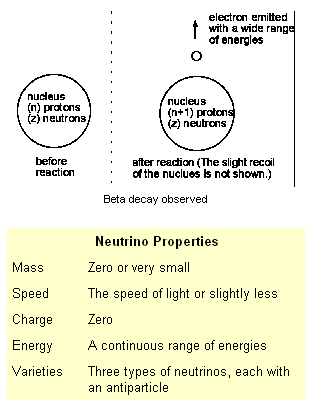
There it stood for 25 years. But advances in nuclear physics and the development of nuclear reactors made possible new experiments, and two physicists, Frederick Reines and Clyde Cowan, set out to find neutrinos emitted by a reactor core. They succeeded in 1956, by observing a nuclear reaction initiated by the absorption of a neutrino, essentially the reverse of beta-decay. Their work established neutrino physics as a legitimate field, and Reines won the Nobel prize in 1995. (Cowan died in 1974.)
Where do neutrinos come from? Most neutrinos that reach Earth—a huge number, some tens of billions per square centimeter—come from nuclear reactions in the sun. Once physicists had detected solar neutrinos, a second great neutrino mystery developed in the 1970s, because the number observed was only about a third of what was expected. Only around the turn of the 21st century did physicists begin to make progress in solving this problem. (See Neutrino Astrophysics)
Research
To explain the deficit in the number of observed solar neutrinos, physicists hypothesized that some changed from one type to another in mid-flight from the sun to Earth, thus reducing the number detected. Nearly 40 years passed before any evidence supporting this prediction was found. An investigation of neutrinos produced in the atmosphere by cosmic rays supports the existence of this change of type, called neutrino “oscillation.”
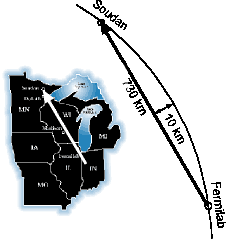
Schematic representation, not to scale, of the underground path of the MINOS neutrino beam from Fermilab, in Batavia, Illinois to an iron mine in Soudan, Minnesota. Neutrino properties, and in particular a change or “oscillation” from one type of neutrino to another, will be determined by careful measurements at Batavia and at Soudan. (adapted from a diagram supplied by Fermilab)
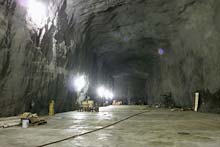
Neutrino detector space when Minos detector construction began, 700 meters deep in the Soudan Mine (photo courtesy of Jerry Meier, University of Minnesota).
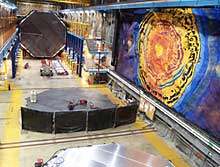
The background of this picture shows the sandwich of iron slabs and plastic, with the next slab to be installed visible in the foreground. The neutrino beam direction is along the axis of these slabs. Note the mural at the right, which is part of the MINOS outreach effort. (photo courtesy of Jerry Meier, University of Minnesota)
An entirely different approach—an experiment called Main Injector Neutrino Oscillation Search (MINOS)—actually produces a neutrino beam. Although neutrinos cannot be focused, since they have no electric charge, they can be created from a beam of unstable subnuclear particles, which can be focused. These particles’ decay products include neutrinos. Conservation of momentum causes the particles to emit these neutrinos preferentially in the forward direction. In this way, physicists will create an intense neutrino beam, aimed through solid Earth from Fermilab, in Batavia, Illinois, to a detector 450 miles away in an iron mine in Soudan, Minnesota, as shown in the diagram. Detailed measurements of the numbers of neutrinos, their energy spectra, and the way they interact in the detectors at both sites will reveal whether the neutrinos have oscillated.
The far detector, at Soudan, is located deep underground. This is necessary because the neutrino beam from Fermilab will spread out from just a few kilometers wide to several kilometers wide when it reached Soudan. Consequently, the rate of interaction at Soudan is very low, only one interaction every few hours, so this detector must be screened from particles that might be mistaken for neutrinos. Indeed, particles called muons, produced in the atmosphere by cosmic rays, can penetrate underground and be detected, just like the products of the neutrino-induced reaction that provides the neutrino count. The detector must be deep enough to make the background count from muons insignificant, so this physics lab is built in a mine. The empty experimental hall, before detector construction, is shown in the first photograph.
The Soudan detector consists of nearly 500 magnetized iron slabs, each one 8 meters across and one inch thick, separated by plastic material that detects the charged particles produced when neutrinos interact in the iron slabs. The second photo shows the accumulating layers of iron and plastic, which eventually will extend almost the full length of the experimental hall. The detector is expected to be fully operational in the summer of 2003.
Through this giant sandwich of plastic and iron will pass about 500 billion neutrinos each month, but only about 750 of these will be detected. This lack of interaction is what makes neutrino physics so difficult.
Neutrino oscillation is important both as fundamental physics and also as part of cosmology—the study of the universe—since very large amounts of neutrinos were produced shortly after the Big Bang. In fact, there is a predicted neutrino background that corresponds to the microwave background (See Physics In Action, Catch a Cosmic Microwave), and the search for these cosmic neutrinos is already underway.
Links
Fermilab
Physics in Action
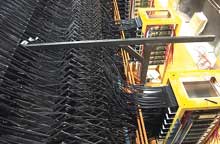
Fiber optics “wiring” carrying light signals from plastic layers between iron slabs in the MINOS detector (photo courtesy of Jerry Meier, University of Minnesota)














